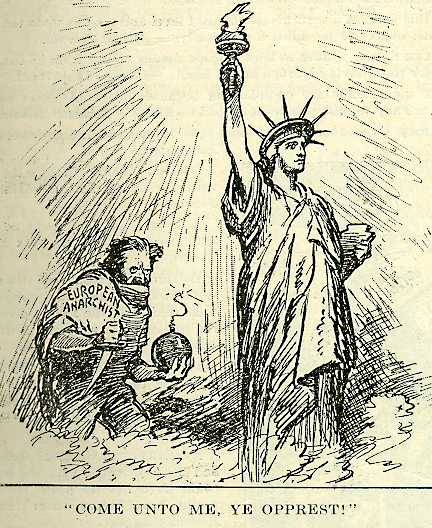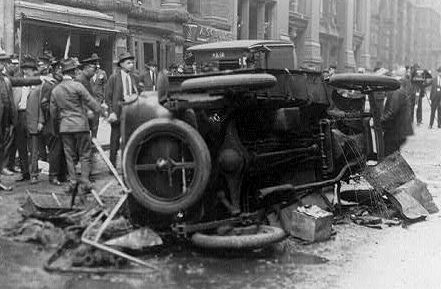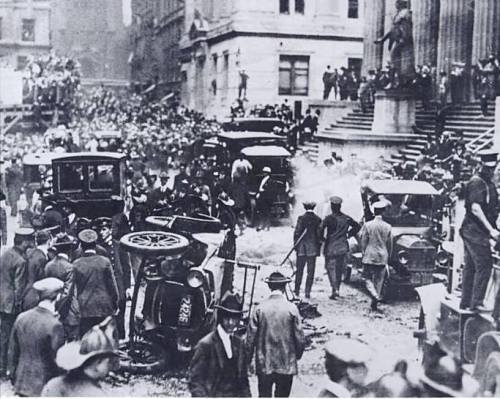America’s first large scale terrorist attacks, part I — The Bombing of 1919 and the Wall
America’s first large scale terrorist attacks, part I — The Bombing of 1919 and the Wall Street Bombing of 1920.Today we remember the terrible tragedy of the 9/11 terrorist attacks, the most deadly terrorist attack on American soil. When Americans think of terrorism, usually visions of the World Trade Center, the Pentagon, the Boston Marathon, and perhaps the Oklahoma City Bombings come to mind. While terrorism in America is certainly a terrible specter in modern day American life it certainly is not anything new. After World War I, midst an era of social and political upheaval, America would experience it first taste of large scale terrorism.It all began in 1919, an uneasy time when the Bolsheviks had taken over Russia, revolutionary anarchists threatened public order, women and minorities demanded their rights, and labor unrest spread around the country. In late April of 1919 a series of 36 booby trap mail bombs were shipped to high profile public officials around the country, including politicians, law enforcement officers, journalists, and business leaders. Among the targets were historic figures such as John D. Rockefeller, J.P. Morgan, Kennesaw Mountain Landis (first commissioner of baseball), and Supreme Court Justice Oliver Wendel Holmes. Since most famous and important people don’t open their own mail, none of those targeted were harmed. In fact 12 were intercepted before they could be delivered. However the bombs killed or injured a number of bystanders such as secretaries and servants.On June 2nd, 1919 eight bombs consisting of 25 lbs of TNT exploded simultaneously in eight US cities. Again targets were government officials, justice officials, and law enforcement officials. Once again the bombings did not harm their intended targets but caused grave collateral damage and the death of two bystanders. This time, however, each of the bombs came with a printed flyer which read,“ War, Class war, and you were the first to wage it under the cover of the powerful institutions you call order, in the darkness of your laws. There will have to be bloodshed; we will not dodge; there will have to be murder: we will kill, because it is necessary; there will have to be destruction; we will destroy to rid the world of your tyrannical institutions.”The police were able to trace the flyer to a printing shop operated by two followers of Luigi Galleani, an Italian anarchist who was popular in the early 20th century. In response many known Galleanists were rounded up and deported.Finally on September 16th, 1920, a horse drawn wagon loaded with 100 pounds of explosives and 500 pounds of sash weights (for shrapnel) exploded at 12:00 pm on Wall Street in front of the J.P. Morgan bank. The blast resulted in the deaths of 38 people, mostly clerks, brokers, and messengers who were on lunch break. Hundreds more were wounded. Up to that time the US had never experienced such a well coordinated and deadly terrorist attack. Police and medical personnel were so unprepared for the devastation that they had to commandeer vehicles to evacuate the dead and the wounded. While the Galleanist’s were suspected of the crime, a revenge attack for the arrest of Sacco and Vanzetti, it was never conclusively proven who had committed the massacre.The wave of terrorism that occurred in the US from 1919 to 1920 drove a fear into the hearts of Americans that they have never experience before. Like most major acts of terrorism, the most profound results of the bombings occurred in the aftermath. While anarchists were responsible for the bombings, the attacks would set off an anti communist witch hunt known as the First Red Scare. One of the targets of the bombings was the Attorney General A. Mitchell Palmer, who along with his young protege, J. Edgar Hoover, vowed to use very heavy handed tactics to end the terrorist threat. -- source link
Tumblr Blog : peashooter85.tumblr.com
#history#terrorism#1919#wall street#bombs#bombings#anarchy#anarchists#galleanists#mail bombs#death#terror


